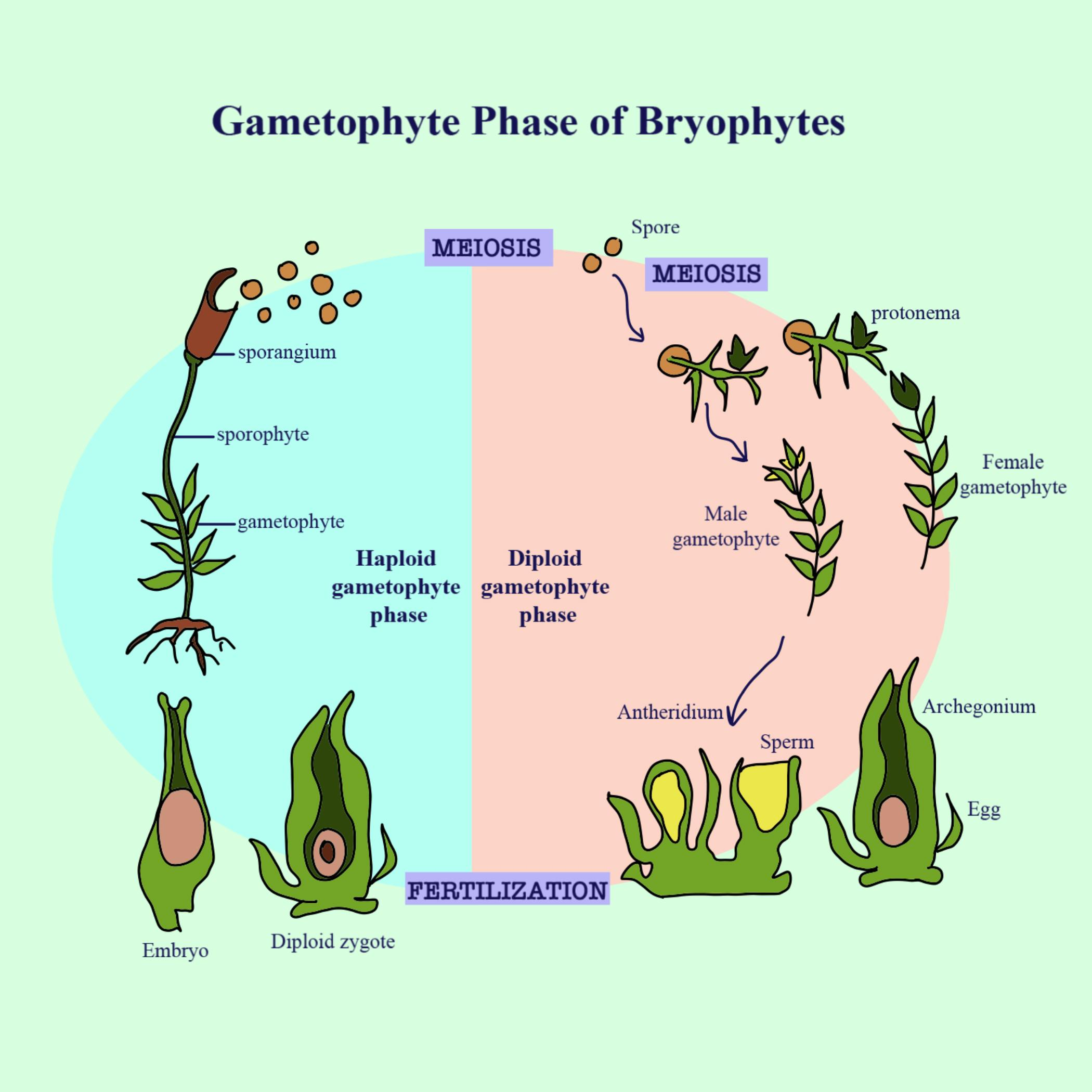
Explain the alternation of generations in bryophytes.
Answer
552.6k+ views
Hint The amphibians of the plant kingdom reproduce sexually by the fusion of gametes resulting in the zygote that forms into a sporophyte instead of undergoing meiosis. Bryophytes' life cycle contains both haploid and diploid cells.
Complete answer:
In bryophytes the main plant body is haploid and it produces gametes, hence called gametocyte. They contain multicellular, stalked, and jacketed sex organs. Antheridium is the male sex organ. Archegonium is the female sex organ. Antheridium produces biflagellate antherozoids. The female sex organ produces a single egg. it is flask-shaped. Male gametes are released into the water where they fuse with the female gamete. Their fusion results in the formation of a zygote. This is called zooidogamous oogamy. In bryophytes, the formed zygote does not undergo meiosis immediately. It produces sporophyte which is a multicellular body, free-living but attached to the photosynthetic gametes for an energy source. Some of the cells (spore mother cells) undergo meiosis and produce haploid cells which further germinate to produce gametophyte. All bryophytes are homosporous. They show heteromorphic alternation of generations because gametophytic and sporophytic bodies are conspicuously different. They show a haplo-diplontic life cycle.
Additional information:
- Bryophytes generally have less economic importance but some bryophytes like mosses provide food for herbaceous animals, birds, and other mammals.
- Sphagnum, commonly called peat moss is used as a fuel and also used as packing material for transshipment of living material because of its capacity to hold water.
- Hepaticopsida(liverworts), anthocerotopsida(hornworts), and Bryopsida(mosses) are the three classes of bryophytes.

Note:
-Bryophytes can grow both on land and in water.
-They are the primitive land plants that occur in humid, damp, and shaded places.
-In-plant succession on bare rocks or soil, bryophytes play an important role.
Complete answer:
In bryophytes the main plant body is haploid and it produces gametes, hence called gametocyte. They contain multicellular, stalked, and jacketed sex organs. Antheridium is the male sex organ. Archegonium is the female sex organ. Antheridium produces biflagellate antherozoids. The female sex organ produces a single egg. it is flask-shaped. Male gametes are released into the water where they fuse with the female gamete. Their fusion results in the formation of a zygote. This is called zooidogamous oogamy. In bryophytes, the formed zygote does not undergo meiosis immediately. It produces sporophyte which is a multicellular body, free-living but attached to the photosynthetic gametes for an energy source. Some of the cells (spore mother cells) undergo meiosis and produce haploid cells which further germinate to produce gametophyte. All bryophytes are homosporous. They show heteromorphic alternation of generations because gametophytic and sporophytic bodies are conspicuously different. They show a haplo-diplontic life cycle.
Additional information:
- Bryophytes generally have less economic importance but some bryophytes like mosses provide food for herbaceous animals, birds, and other mammals.
- Sphagnum, commonly called peat moss is used as a fuel and also used as packing material for transshipment of living material because of its capacity to hold water.
- Hepaticopsida(liverworts), anthocerotopsida(hornworts), and Bryopsida(mosses) are the three classes of bryophytes.

Note:
-Bryophytes can grow both on land and in water.
-They are the primitive land plants that occur in humid, damp, and shaded places.
-In-plant succession on bare rocks or soil, bryophytes play an important role.
Recently Updated Pages
Master Class 11 Economics: Engaging Questions & Answers for Success

Master Class 11 English: Engaging Questions & Answers for Success

Master Class 11 Social Science: Engaging Questions & Answers for Success

Master Class 11 Biology: Engaging Questions & Answers for Success

Class 11 Question and Answer - Your Ultimate Solutions Guide

Master Class 11 Business Studies: Engaging Questions & Answers for Success

Trending doubts
10 examples of friction in our daily life

One Metric ton is equal to kg A 10000 B 1000 C 100 class 11 physics CBSE

Difference Between Prokaryotic Cells and Eukaryotic Cells

1 Quintal is equal to a 110 kg b 10 kg c 100kg d 1000 class 11 physics CBSE

State the laws of reflection of light

Explain zero factorial class 11 maths CBSE




